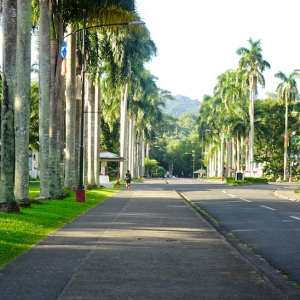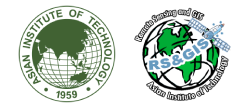
Agro-Informatics This domain leverages geospatial technologies to achieve agricultural optimization by enhancing productivity and promoting sustainability. The expanded focus now includes:
- Yield Estimation and Forecasting: Utilizing remote sensing data and GIS analytics to estimate crop yields and forecast future production levels. This includes analyzing historical data trends, weather patterns, and satellite imagery to predict outcomes and assist farmers in making informed decisions.
- Pest Occurrence: Monitoring and predicting pest outbreaks through the analysis of geospatial data. By identifying environmental conditions conducive to pest proliferation, geospatial technologies can help in timely pest control interventions and reduce crop losses.
- Phenology Modeling using Machine Learning, UAVs, and IoT: Implementing advanced technologies such as Machine Learning algorithms, Unmanned Aerial Vehicles (UAVs), and the Internet of Things (IoT) to study and model crop phenology—the timing of plant life cycle events. This can lead to better understanding of crop growth stages, optimal planting and harvesting times, and the effects of climatic variations on crop cycles.
- Crop Focus: Applying geospatial techniques to specific crops including rice, sugarcane, maize (corn), and various cash crops. This tailored approach allows for detailed monitoring and management strategies that cater to the unique requirements and challenges of each crop type, such as irrigation needs, susceptibility to certain pests, and specific harvest windows.
Environmental Monitoring and Conservation This domain harnesses the power of remote sensing and GIS for comprehensive environmental stewardship. The focus areas within this domain include:
Natural Resource Management: Applying geospatial technologies to the sustainable management of natural resources such as water, forests, and minerals. This includes monitoring changes in land use, detecting illegal activities like deforestation, and optimizing the use of resources to prevent depletion and ensure ecosystem services are maintained.
Biodiversity Conservation: Utilizing satellite imagery and spatial data to map habitats, track wildlife populations, and identify areas of high conservation value. Geospatial tools can help in creating protected area networks, monitoring species diversity, and implementing restoration projects to prevent species loss and ecosystem degradation.
Climate Change Impact Assessment: Analyzing the effects of climate change on various ecosystems and human settlements using geospatial data. This involves the study of sea-level rise, glacial retreat, shifts in vegetation zones, and the incidence of extreme weather events to support adaptation and mitigation strategies.
Environmental Health Monitoring: Monitoring environmental factors that affect human health, such as air and water quality, toxic waste sites, and pollution sources. Geospatial technologies provide the means to assess risk, model the spread of contaminants, and inform public health decisions.
Ecosystem Services Evaluation: Mapping and valuing the services provided by ecosystems, such as carbon sequestration, water filtration, and pollination. GIS and remote sensing can quantify these benefits, which is crucial for informed policy-making and environmental planning.
Land Cover and Land Change Analysis: Studying changes in land cover over time to understand the dynamics of natural and human-induced alterations. This analysis is essential for tracking deforestation, urban expansion, and agricultural encroachment, as well as for planning sustainable land management practices.


Geospatial Technologies in Climate Change Adaptation This domain focuses on the use of geospatial tools to address the challenges posed by climate change. By leveraging remote sensing, GIS, and other technologies, this field aims to enhance resilience and enable communities, ecosystems, and economies to adapt to the changing climate. Key areas include:
Geospatial Technologies in Climate Change Adaptation: This domain focuses on the use of geospatial tools to address the challenges posed by climate change. By leveraging remote sensing, GIS, and other technologies, this field aims to enhance resilience and enable communities, ecosystems, and economies to adapt to the changing climate. Key areas include:
Vulnerability Assessments: Utilizing geospatial data to identify regions, communities, and ecosystems most at risk from climate change effects such as sea-level rise, extreme weather events, and changing precipitation patterns. These assessments help prioritize areas for intervention and adaptation efforts.
Impact Forecasting: Analyzing current and future climate change impacts on natural and human systems. This involves modeling scenarios using geospatial data to predict changes in temperature, precipitation, and the frequency and intensity of extreme weather events, informing long-term planning and risk management.
Sustainable Adaptation Strategies: Developing and mapping out strategies to adapt to the anticipated changes in climate. This includes designing resilient infrastructure, planning for water resource management under altered hydrological cycles, and adjusting agricultural practices to cope with new growing conditions.
Ecosystem Adaptation: Assessing how ecosystems can be managed to maintain their services in the face of climate change. This might involve mapping migration corridors to facilitate species movement, identifying areas for conservation and restoration, and evaluating the potential for carbon sequestration projects.
Urban Climate Resilience: Addressing the specific challenges faced by urban areas, such as the urban heat island effect, increased flooding risk, and infrastructure vulnerability. Geospatial technologies can support urban planning that incorporates green spaces, water-sensitive urban design, and climate-resilient construction.
Community Engagement and Capacity Building: Using geospatial data to inform and involve communities in the adaptation process. This can involve participatory GIS to include local knowledge in planning, as well as providing education and resources to build local capacity for climate change resilience.
Health Geoinformatics: This domain capitalizes on the power of geospatial tools to enhance public health through improved disease surveillance, health service accessibility, and analysis of environmental health determinants. Key components include:
Disease Surveillance and Mapping: Utilizing GIS to track and visualize the spread of diseases across different geographical regions. By analyzing spatial data, health professionals can identify disease hotspots, understand transmission patterns, and implement targeted interventions.
Accessibility to Health Services: Assessing the distribution of healthcare facilities and services to ensure equitable access. Geospatial analysis helps to identify areas with insufficient healthcare provision and supports the planning of healthcare facility locations to serve underrepresented populations better.
Environmental Health Determinants: Investigating the role of environmental factors such as air and water quality, pollution, and land use changes on health outcomes. Geospatial tools can link environmental exposures to health issues like asthma, allergies, and other chronic diseases.
Healthcare Resource Allocation: Using spatial data to optimize the distribution of healthcare resources, including medical personnel, equipment, and vaccines. This ensures that resources are directed to where they are needed most, especially during health emergencies or outbreaks.
Epidemiological Studies: Employing geospatial analyses in epidemiological research to explore the relationship between location and the frequency of health conditions. This can help in understanding the spread of communicable and non-communicable diseases and the effectiveness of health interventions.
Social Determinants of Health: Analyzing the impact of social factors such as income, education, and ethnicity on health disparities. Geospatial tools can uncover spatial patterns in these determinants to guide policy and intervention strategies for improving public health equity.
Health Risk Assessment: Mapping areas of potential health risks from environmental or man-made hazards. Geospatial analyses can inform communities about their risk levels and guide preventive measures or emergency responses.
Specific Disease Focus:
Malaria: Employing geospatial analysis to understand malaria transmission dynamics, identify high-risk areas, and target interventions effectively.
Chronic Respiratory Diseases: Analyzing spatial patterns of chronic respiratory conditions, including the impact of air quality, urbanization, and other environmental factors on disease prevalence.
Lung Cancer: Investigating geographic variations in lung cancer incidence and potential environmental or occupational exposures contributing to these patterns.
Tuberculosis (TB): Mapping TB cases and hotspots to understand transmission pathways and the impact of socio-economic conditions on TB spread.


Interdisciplinary Geospatial Studies This domain represents a nexus of geospatial science and other fields, facilitating the exploration and understanding of complex global issues. It encompasses:
Ionospheric Scintillation during Extreme Events: This area studies the variability in the Earth's ionosphere caused by solar and space weather events using geospatial technologies. By monitoring ionospheric disturbances, which can affect satellite communications and GPS signals, researchers can develop mitigation strategies to ensure the reliability of navigation and communication systems during such extreme events.
Explosive Trace Detection using Hyperspectral Imaging: This application utilizes hyperspectral sensors to detect the unique spectral signatures of explosive materials from a distance. By analyzing the light reflected from surfaces, hyperspectral imaging can identify traces of explosives in various environments, enhancing security measures and aiding in demining operations.
Archaeological Site Mapping, Modeling, and Virtual Reality: Geospatial tools are used to map and analyze archaeological sites, creating detailed 3D models that can be explored through virtual reality. This immersive approach allows for a non-invasive way to study historical sites, plan excavations, and share archaeological findings with the public and researchers worldwide.
Urban and Regional Planning: This domain emphasizes the strategic use of geospatial tools to guide the development and management of urban and regional environments. It encompasses a range of applications:
Urban Growth Management: Geospatial technologies assist in monitoring and modeling urban expansion to ensure that growth is sustainable and well-planned. GIS can be used to analyze patterns of sprawl, predict future growth areas, and help planners implement smart growth strategies that balance development needs with environmental conservation.
Infrastructure Planning and Analysis: GIS supports the planning, design, and management of infrastructure such as transportation networks, utilities, and public services. Geospatial data helps in optimizing routes, assessing service coverage, and identifying areas in need of infrastructure investment.
Land Use Planning: Remote sensing and GIS are critical for creating land use plans that address the needs of communities while preserving natural resources. They enable the analysis of current land uses, the simulation of land use change scenarios, and the development of zoning regulations to guide future land use decisions.
Sustainable Urban Design: Geospatial tools promote sustainable urban design by facilitating the integration of green spaces, renewable energy sources, and eco-friendly transportation options into urban planning. This includes the assessment of environmental impacts and the optimization of resource use to create livable, resilient cities.
Hazard Mitigation and Climate Adaptation: Urban areas can be particularly vulnerable to natural hazards and climate change. Geospatial technologies help to identify high-risk areas, plan for disaster response, and incorporate climate adaptation measures into urban planning.
Public Participation GIS (PPGIS): Geospatial technologies enable the engagement of the public in the planning process through PPGIS, where community members contribute their knowledge and preferences to inform planning decisions. This leads to more inclusive and responsive urban planning outcomes.
Real Estate and Economic Development: GIS aids in analyzing market trends, property values, and the economic potential of different regions, supporting decision-making in real estate development and economic planning.
Environmental Impact Assessments: Utilizing geospatial analyses to evaluate the potential environmental impacts of proposed development projects, ensuring that urban growth does not come at the expense of environmental quality.

